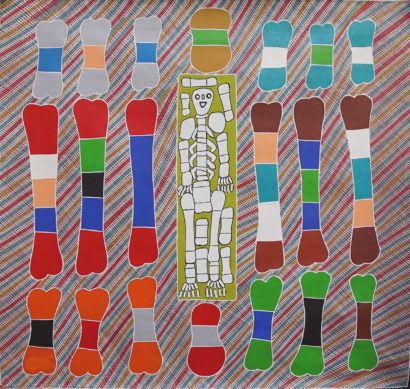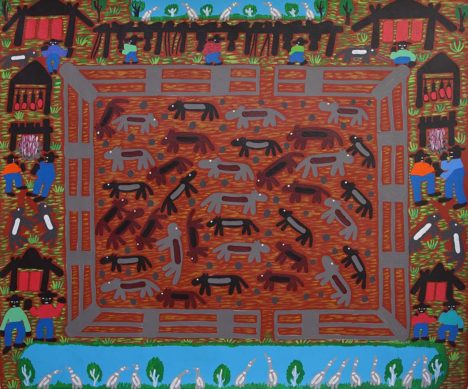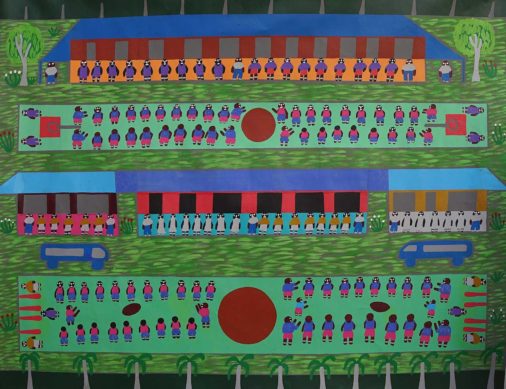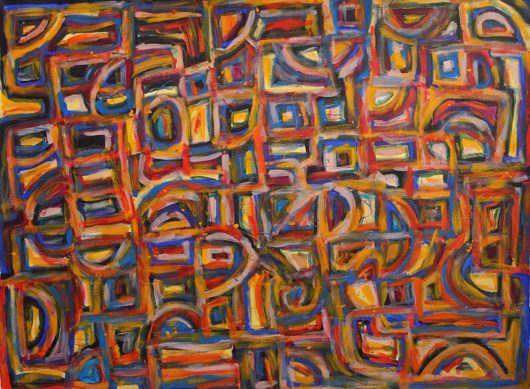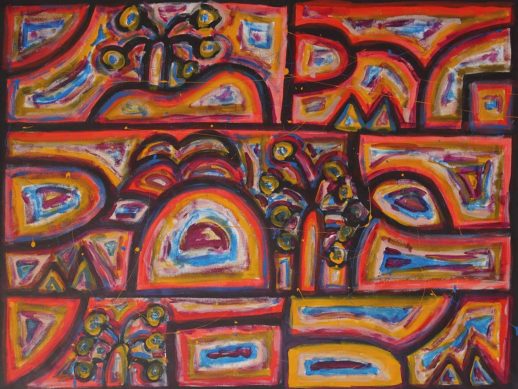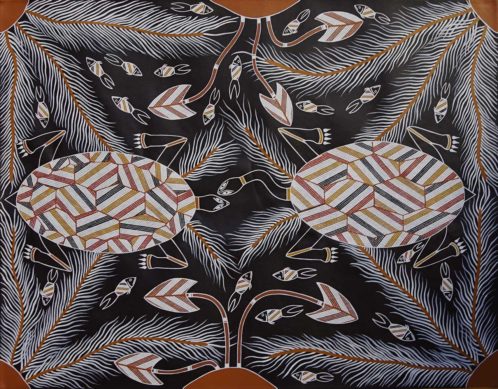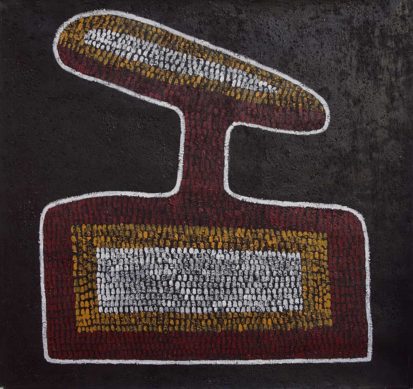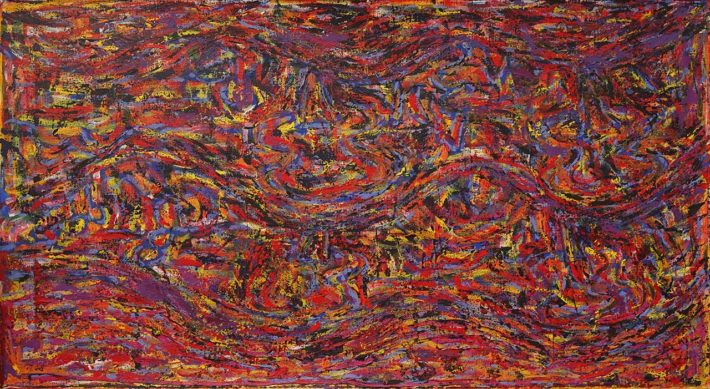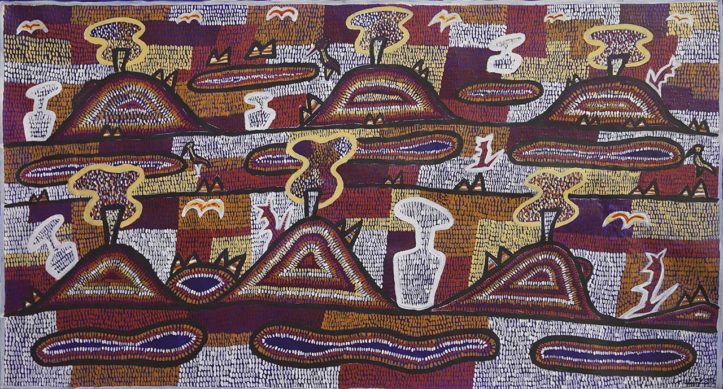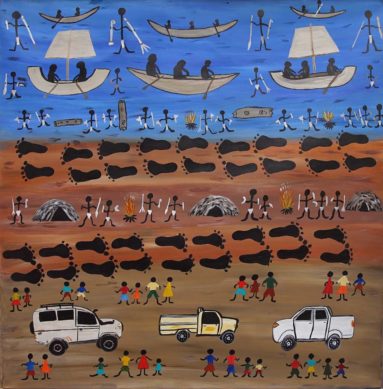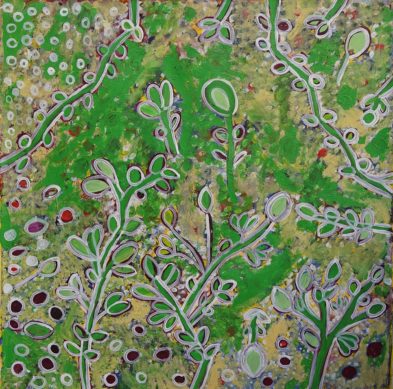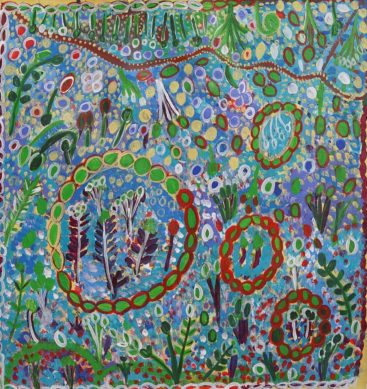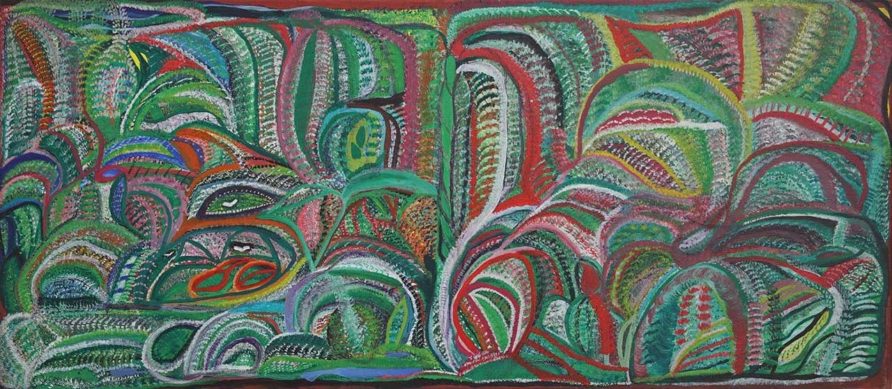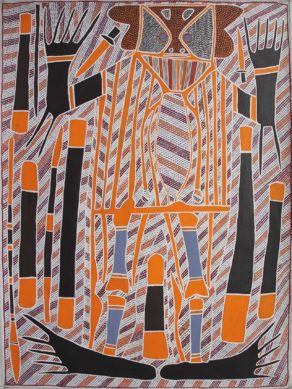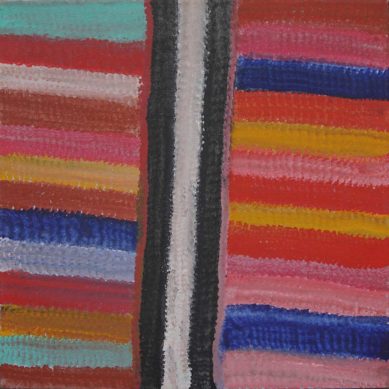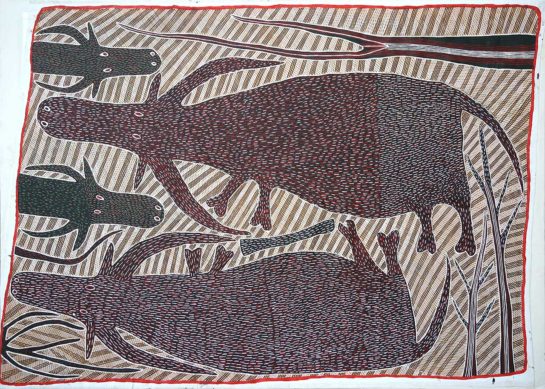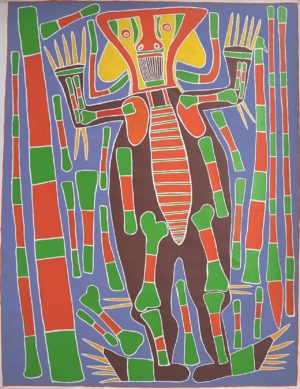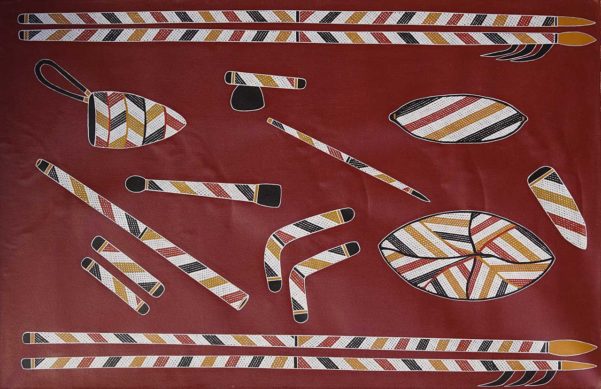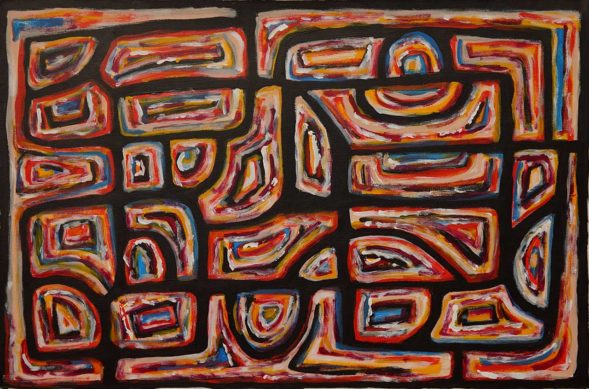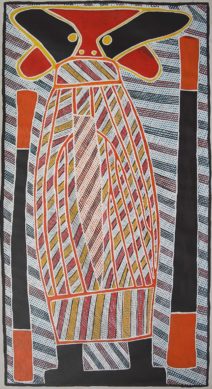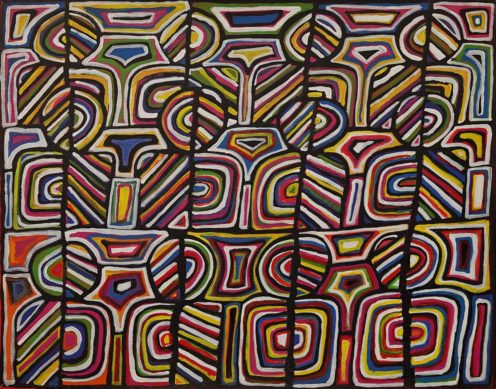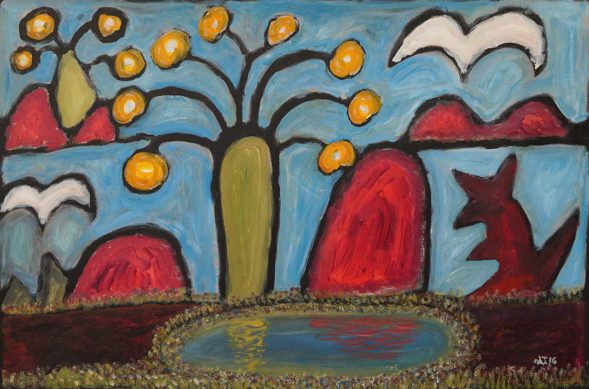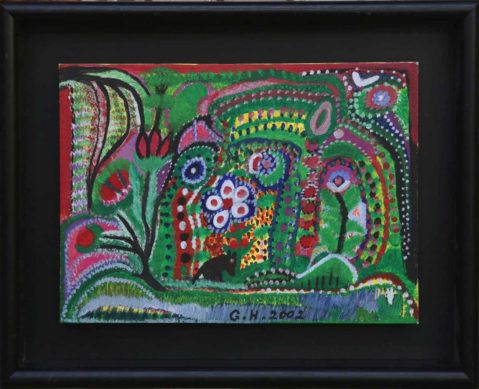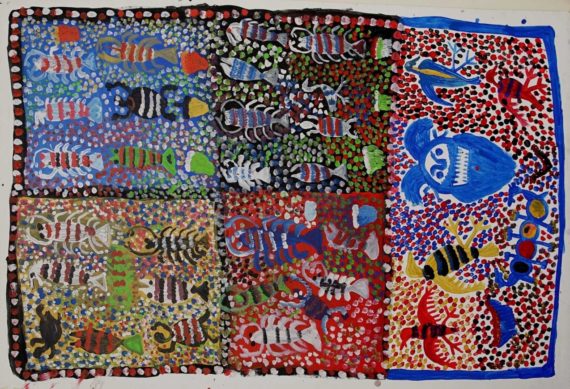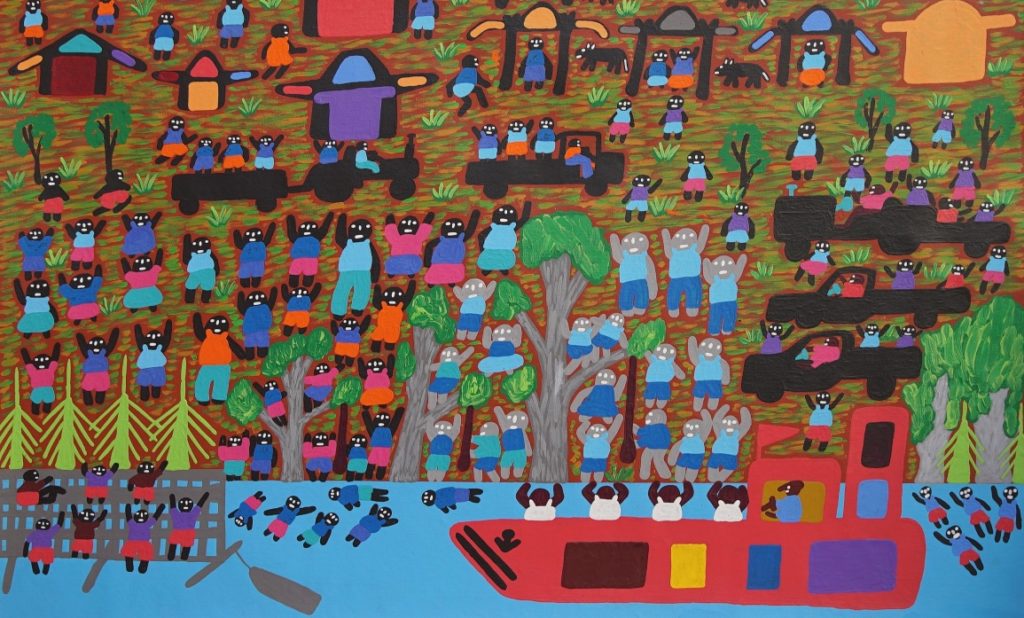Artists from Ngukurr
Gallery 2
22 July – 24 August 2016
Ngukurr art centre has represented a diverse group of artists from S-E Arnhem Land over several decades. The work continues to show the great cultural variation that comes from the nine different language groups that make up the community. Ngukurr community is located on a river crossing of the Roper River and is cut off from road access to the nearest town of Katherine when the river is in full capacity during the wet season. Ngukurr was originally a mission settlement from 1908 to 1968 established for Aboriginal people displaced from their traditional lands. Since then it has been managed by an Aboriginal Council of elders.
The exhibition includes representatives of the current generation of artists working at Ngukurr. They are Wally Wilfred, Alan Joshua, Gwenneth Blitner, Iris Wanambi, Joyce Huddlestone and Karen Rogers. Also represented are some historical works that show the artistic and narrative style developed at Ngukurr. These artists include Willie Gudapi, Djambu Barra Barra, Gertie Huddleston and Maureen Thompson.
No one style has dominated from Ngukurr artists but a strong theme of narrative works showing the living conditions of the people with colourful figurative elements has prevailed. Willie Gudapi (1916-1996) painted his ancestral hunting grounds with an abundance of wild food and always included his grandfather spirit on the lands. His style was colourful and representative of the plants and animals that grew in abundance. So also Gertie Huddleston (c1930-2013) painted the bush gardens grown on the mission and the local landscapes as lush tropical wonderlands. Djambu Barra Barra (c1946-2006) often painted the large animals that were the focus of hunting, and covered them with tribal marks and section lines for when they were to be distributed as meat amongst the people.
This narrative style is carried on in the works of Wally Wilfred and Karen Rogers, while Alan Joshua jnr has kept the colour palette but made more abstract images of his community. Gwenneth Blitner shows the more traditional style of Arnhem Land, using the cross hatching rarrk over traditional animals and utensils.
T”Artists from Ngukurr” is exhibiting at Japingka Gallery from 22 July to 24 August 2016.
View more:
Djambu Barra Barra Artist Bio & Artworks
Roper River Art
Exhibition Walk Through
I’ve just been hanging the new work from Ngukurr Community in south-east Arnhem Land. What an amazing community of artists. There are nine different language and culture groups all living in the one place.
One of the my favourite works is a painting of the painted bones. This is about the whole ceremonial treatment of people after they’ve passed away. The bones have dried out in the landscape. They’re ceremonially painted with ochre and put into a special place. This acrylic painting contains lots of primary colours. In the background there is a fine crosshatch. This is another traditional style, the Rarrk technique from Arnhem Land. This is an unusual combination. It’s telling of a traditional story using a traditional process. Yet it’s then combined with a contemporary style.
This painting also refers to other paintings by the artist Djambu Barra Barra. He also recorded traditional cultural ceremonies and expressed them in paintings in this way. So his grandson is carrying on this tradition.
The exhibition includes another painting by Wally Wilfred about Ngukurr in the 1970s. It’s a naïve colorful painting with a lot of figures in it. You can see barges coming in and children swimming in the water. Everyone’s come down to the bank of the river and the trucks are there. It is about the supplies coming into the community. There’s great energy in the painting. This is a community that’s alive and vital. This is the artist’s memories of the community during his lifetime, a visual history.
It’s a joyful work. For all the things Aboriginal communities deal with, they do tend to maintain this view of the whole community. The interaction of the community is the most critical thing in their lives.
The exhibition also has some great works by Alan Joshua. He’s painted something that looks quite contemporary. It’s made entirely of lines with no figurative elements.
It’s almost like lots of boxes that have been separated out. There is base colour and multiple overlying lines of colour. These paintings refer to his Grandmother’s country. They refer to certain locations, caves and other sites in the landscape. Some of of his paintings also have elements that could be hills and trees. Then other paintings go right into an abstract realm, and could be read as abstract paintings, though the artist is still thinking about the country that he’s representing when he paints.
The exhibition also includes some works about bush gardens. This whole other tradition comes from the more figurative style of Gertie Huddleston. She painted the gardens around the mission. These are a combination of natural landscape and cultivated bush gardens. They are often overflowing with abundance with everything flowering and trees bearing fruit.
Some of Gertie’s works were even named “Garden of Eden”. I guess it’s her homage to the way people are interacting with the land and growing or harvesting bush foods. We’ve got a couple of paintings here in this tradition from her daughter Joyce Huddleston. One shows lots of bush flowers in brilliant pink and another just showing the bush. Other work features the fresh water billabongs around this country.
We will be hanging two older works by Gertie Huddleston. Even though Gertie has passed away, her works have created a strong tradition that is carried on by younger artists in the community.
Another interesting work in the exhibition by Wally Wilfred shows the sports ground. You see footballers lined up. There’s a game of basketball going on in the top. There’s the sports ground with different pavilions.
There’s people all sitting around or standing around the edges of the sports event. You see palm trees at the bottom. There is a football game going on at another ground. Again, it’s naïve, it’s colourful, it’s joyful. It’s a celebration of the whole community coming out for events. The artist has called this painting “Lost Generation Mob”. Maybe it’s a comment about the change from ceremonial life to sporting life. This will be a story that we’d love to hear from Wally when he is here.
Another work I’m quite taken with is a very traditional painting by Iris Wanambi. This is perhaps more like what we might expect to see from Arnhem Land. It includes turtles and fish and lily pads. It’s a billabong scene painted in traditional colours. There’s yellow and a brown as well as cream and a black. The turtle shells have the traditional Rarrk crosshatch pattern on them. This is one aspect of traditional painting we see from this community.
There’s a constant evolution of artwork by artists working together. Some have stayed with the traditional ways of painting. Others have found their own ways of telling stories about their community. These look completely different from the rock paintings and the traditional artwork.
Another interesting work is here by Alan Joshua. It is highly stylized. There’s a big fruiting tree and and a big white bird or a cloud. The shapes are highly simplified, the colours are blocked in. Like many of his other works it’s quite painterly. They’re quite loose and expressionistic. The artist obviously enjoys the process of putting paint on canvas. This is almost like a little scene with a waterhole, trees, rocks and a kangaroo coming down to the water. The whole thing has been stylized almost into a pattern that links up to form a design. That’s a whole other approach to story telling and art making.
Hanging this new work from the Ngukurr has been a pleasure. Our official launch for this exhibition is on 22 July. You don’t have to wait until then. Drop by and see why we feel the Ngukurr art community is something special.
Read more:

